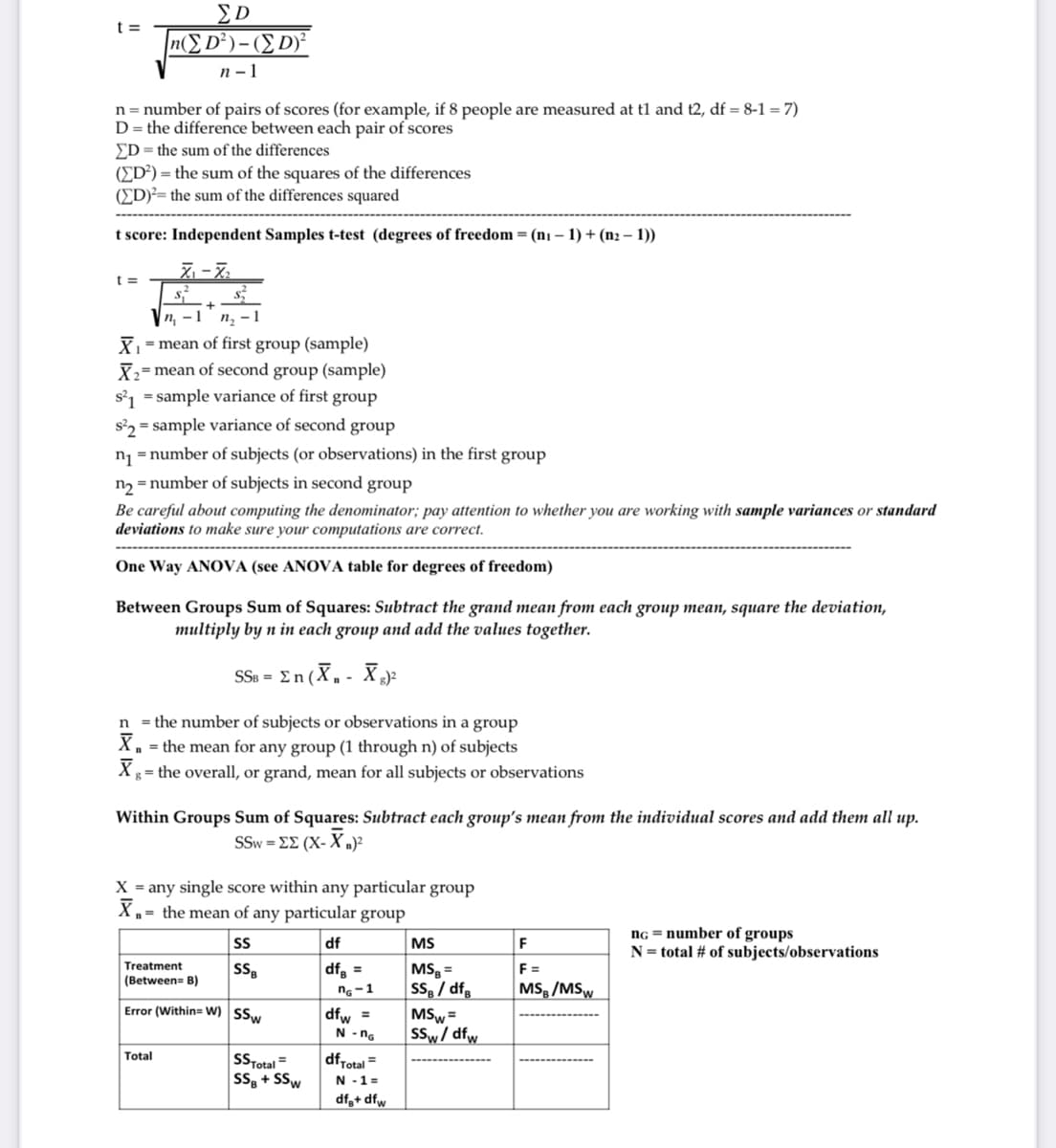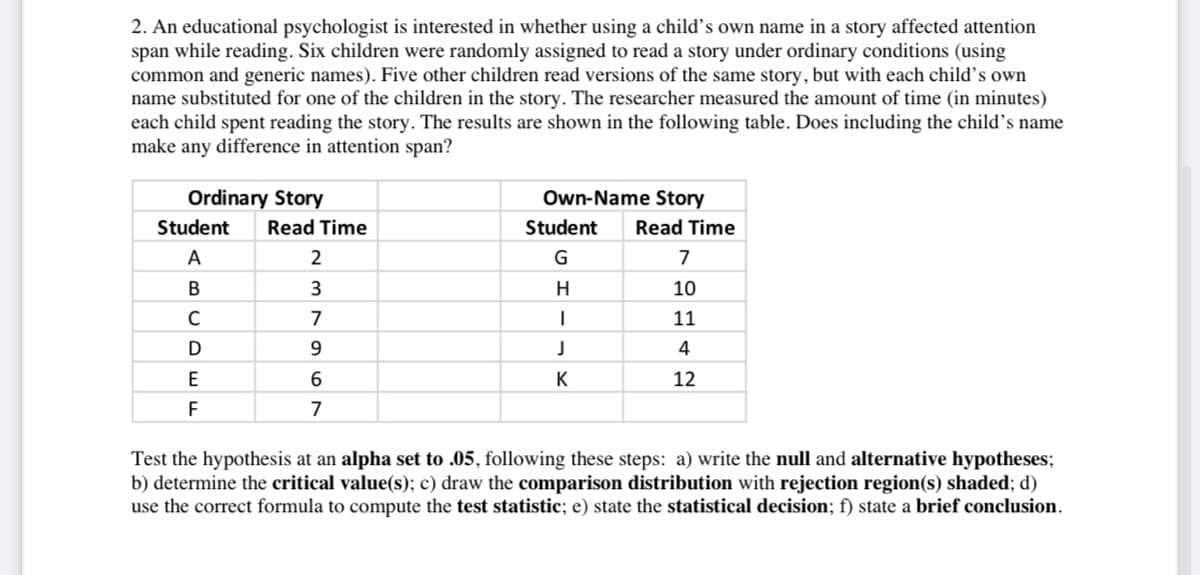2. An educational psychologist is interested in whether using a child's own name in a story affected attention span while reading. Six children were randomly assigned to read a story under ordinary conditions (using common and generic names). Five other children read versions of the same story, but with each child's own name substituted for one of the children in the story. The researcher measured the amount of time (in minutes) each child spent reading the story. The results are shown in the following table. Does including the child's name make any difference in attention span? Ordinary Story Own-Name Story Student Read Time Student Read Time A 2 G 7 B 3 H 10 C 7 11 D 4 E K 12 F Test the hypothesis at an alpha set to .05, following these steps: a) write the null and alternative hypotheses; b) determine the critical value(s); c) draw the comparison distribution with rejection region(s) shaded; d) use the correct formula to compute the test statistic; e) state the statistical decision; f) state a brief conclusion. 967
2. An educational psychologist is interested in whether using a child's own name in a story affected attention span while reading. Six children were randomly assigned to read a story under ordinary conditions (using common and generic names). Five other children read versions of the same story, but with each child's own name substituted for one of the children in the story. The researcher measured the amount of time (in minutes) each child spent reading the story. The results are shown in the following table. Does including the child's name make any difference in attention span? Ordinary Story Own-Name Story Student Read Time Student Read Time A 2 G 7 B 3 H 10 C 7 11 D 4 E K 12 F Test the hypothesis at an alpha set to .05, following these steps: a) write the null and alternative hypotheses; b) determine the critical value(s); c) draw the comparison distribution with rejection region(s) shaded; d) use the correct formula to compute the test statistic; e) state the statistical decision; f) state a brief conclusion. 967
Glencoe Algebra 1, Student Edition, 9780079039897, 0079039898, 2018
18th Edition
ISBN:9780079039897
Author:Carter
Publisher:Carter
Chapter10: Statistics
Section: Chapter Questions
Problem 13PT
Related questions
Question

Transcribed Image Text:t =
n(ED²)-(E D)²
n – 1
n = number of pairs of scores (for example, if 8 people are measured at tl and t2, df = 8-1 = 7)
D= the difference between each pair of scores
ED = the sum of the differences
(ED²) = the sum of the squares of the differences
(ED)²= the sum of the differences squared
t score: Independent Samples t-test (degrees of freedom = (n1 – 1) + (n2 – 1))
t =
п, —1
п,- 1
X1- mean of first group (sample)
X2= mean of second group (sample)
s'1 = sample variance of first group
s?2 = sample variance of second group
n1 =number of subjects (or observations) in the first group
nɔ = number of subjects in second group
Be careful about computing the denominator; pay attention to whether you are working with sample variances or standard
deviations to make sure your computations are correct.
One Way ANOVA (see ANOVA table for degrees of freedom)
Between Groups Sum of Squares: Subtract the grand mean from each group mean, square the deviation,
multiply by n in each group and add the values together.
SSsΣη
En(X,- X²
n = the number of subjects or observations in a group
X. = the mean for any group (1 through n) of subjects
g = the overall, or grand, mean for all subjects or observations
Within Groups Sum of Squares: Subtract each group's mean from the individual scores and add them all up.
SSw = EE (X- X .)²
X = any single score within any particular group
X,= the mean of any particular group
nG = number of groups
N= total # of subjects/observations
S
df
MS
F
Treatment
(Between= B)
SS,
dfg =
F =
MS, =
SS, / dfg
MS /MSw
ng-1
Error (Within= W) SSw
dfw =
N - ng
MSw =
SSw/ dfw
Total
SSTotal=
SS, + SSw
dfrotal =
N -1=
df,+ dfw

Transcribed Image Text:2. An educational psychologist is interested in whether using a child's own name in a story affected attention
span while reading. Six children were randomly assigned to read a story under ordinary conditions (using
common and generic names). Five other children read versions of the same story, but with each child's own
name substituted for one of the children in the story. The researcher measured the amount of time (in minutes)
each child spent reading the story. The results are shown in the following table. Does including the child’s name
make any difference in attention span?
Ordinary Story
Own-Name Story
Student
Read Time
Student
Read Time
A
2
G
7
В
3
H
10
7
11
9.
4
E
6.
K
12
F
7
Test the hypothesis at an alpha set to .05, following these steps: a) write the null and alternative hypotheses;
b) determine the critical value(s); c) draw the comparison distribution with rejection region(s) shaded; d)
use the correct formula to compute the test statistic; e) state the statistical decision; f) state a brief conclusion.
Expert Solution
This question has been solved!
Explore an expertly crafted, step-by-step solution for a thorough understanding of key concepts.
This is a popular solution!
Trending now
This is a popular solution!
Step by step
Solved in 4 steps with 1 images

Recommended textbooks for you

Glencoe Algebra 1, Student Edition, 9780079039897…
Algebra
ISBN:
9780079039897
Author:
Carter
Publisher:
McGraw Hill

Holt Mcdougal Larson Pre-algebra: Student Edition…
Algebra
ISBN:
9780547587776
Author:
HOLT MCDOUGAL
Publisher:
HOLT MCDOUGAL

Glencoe Algebra 1, Student Edition, 9780079039897…
Algebra
ISBN:
9780079039897
Author:
Carter
Publisher:
McGraw Hill

Holt Mcdougal Larson Pre-algebra: Student Edition…
Algebra
ISBN:
9780547587776
Author:
HOLT MCDOUGAL
Publisher:
HOLT MCDOUGAL